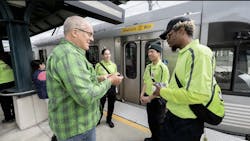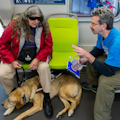Transit agencies rollout customer experience programs to attract riders, boost satisfaction
Across America, transit agencies are launching customer experience (CX) programs to improve customer satisfaction, attract riders and boost morale. In all, nearly 70 transit agencies have embarked on a CX journey in the U.S. and Canada.
Here is an update on many of the programs.
Los Angeles County Metropolitan Transportation Authority (L.A. Metro)
L.A. Metro launched its CX Program in 2020 to sharpen its focus on customers. L.A. Metro conducts CX surveys to identify pain points and creates CX plans to remedy issues such as cleanliness, security, bus stop shade and seating, customer information and time competitiveness.
L.A. Metro CX Plans have spawned nearly 100 initiatives and over $200 million in investments to improve the customer experience. One of the initiatives, for example, deploys over 300 transit ambassadors on the system to enhance safety and customer service. The L.A. program also promotes CX culture, establishes key experience indicators and institutionalizes CX into budgeting, performance appraisals and other business processes.
Metropolitan Atlanta Rapid Transit Authority (MARTA)
MARTA in Atlanta also has an extensive CX program. It named its first chief customer experience officer (CXO) in 2020 to prioritize customer centricity. The CXO serves as an internal customer advocate, partnering with other business units to make customers the center of business decisions. The MARTA CX team includes innovation, customer services, sustainability and customer insights. It oversees a Riders’ Advisory Council, homeless outreach, transit ambassadors and special events planning. Initiatives include improvements to fare collection and customer information and a SMART restroom program that alerts staff when supplies are low or cleaning is needed.
CX comes to Texas
A new CX program at Dallas Area Rapid Transit (DART) grew out of DART’s 2024 Strategic Plan. It resides in the Strategy and Transformation Department, which reports to the chief of staff. CX at DART encompasses not only external riders, but also internal staff, recognizing that the quality of the employee experience ultimately impacts customers. DART has a 360° CX Collaboration team to align insights and initiatives to remedy customer pain points. DART recently engaged Transit CX to review DART business practices to identify areas that could be more closely tied to customer needs.
This review covered 20 areas ranging from the budget process to product design and service standards and from hiring and training to employee recognition. This will culminate in a multi-year roadmap of activities to modify business processes and culture to make customer centricity ubiquitous in everything DART does.
Also in Texas, Trinity Metro in Fort Worth has a CX program that includes travel training for new customers or those with special needs, Transit ENVOYs to assist customers and improvements at stations and transfer centers.
Pennsylvania agencies prioritize CX
In Philadelphia, the Southeastern Pennsylvania Transportation Authority (SEPTA) created a unified CX department in 2025, bringing together customer service, consumer research, digital products and wayfinding staff. The new team gleans insights from surveys, focus groups and customer feedback to improve the customer journey. Recent improvements include a new website, app and signage. One area of emphasis is accurate real-time information and improved communications about bus detours. Internally, the SEPTA CX team promotes the idea that all employees own the customer experience and provide essential internal service to other employees or external service to paying customers.
Also in Pennsylvania, Pittsburgh Regional Transit (PRT) established a CX Department inside operations in 2022. Customer experience is one of three core values in PRT’s strategic plan. PRT uses customer satisfaction surveys to identify and remedy pain points.
PRT trained supervisors and frontline employees, improved employee communications and expanded recognition programs. It also decreased discourtesy complaints by sending operators with high complaint levels to CX and de-escalation training. Interestingly, to enhance the employee experience, PRT uses real-time QR codes at operator comfort stops. PRT also coordinates leadership team trips into the field to experience both the customer journey and the experience of employees.
St. Louis Metro Transit
St. Louis Metro Transit has an interdepartmental CX team to advance a customer first approach to service delivery. The St. Louis Metro CX program aims to understand customer needs, reduce effort and friction, create emotionally positive interactions and supplement operational metrics (what happened) with experience metrics (how customers feel). CX techniques include journey mapping, listening sessions, online surveys and customer feedback. Initiatives include improvements to real-time service alerts, real-time paratransit ride tracking, wayfinding for visually and mobility-impaired customers through QR codes, Light Detection and Ranging scanning of bus routes and stops, audit of current training modules and employee recognition for outstanding service to customers.
CX in Washington state
Community Transit and Sound Transit were early leaders in the CX movement. Community Transit hired its first CX director in 2016. They compile information on the voice of the customer and test innovative approaches to meeting their needs. They also work to create a seamless experience across their region and train employees to walk in a customer's shoes.
Sound Transit appointed its first chief passenger experience officer in 2018, who advocates for passengers across the agency. The passenger experience team tests new technologies and conducts research to improve the passenger experience. A wayfinding and signage team ensures that signs are simple, seamless and intuitive. A passenger care team supports customers, sends rider alerts and manages accessibility services. A passenger success team deploys fare ambassadors and supports passengers in crisis and/or experiencing homelessness.
Elsewhere in Washington state, Pierce Transit is executing a CX plan that includes improvements to the website, transit center, bus stop wayfinding, customer service availability and training to empower frontline staff to be agency ambassadors. Pierce Transit is also installing QR codes to facilitate customer feedback.
C-TRAN in Clark County has a CX program that includes on-street customer service, travel training for seniors, visual wayfinding and gathering rider feedback. The agency partners with Aira to provide wayfinding assistance to people who are blind, including riders to the State School for the Blind in Vancouver, Wash.
Utah Transit Authority (UTA)
The UTA created a CX team in 2018. The UTA CX Team improves wayfinding, real-time information and bus stop amenities and uses customer satisfaction surveys to gauge customer satisfaction with the changes.
In 2024, UTA completed its first CX Action Plan that looks at a customer's entire journey door to door and their mindset during stages of the journey. This plan uses customer vignettes to help UTA more deeply understand the lived experience of UTA customers. UTA will begin to implement recommendations from the Action Plan in 2025.
CX sees progress in Ohio
In December 2024, the Greater Cleveland Regional Transit Authority (GCRTA) launched a CX department to drive innovation and enhance CX by understanding and advocating for customer needs and overseeing a balanced scorecard approach to performance. GCRTA gathers customer insights through observation, customer feedback, CX surveys (randomized, on-board intercepts) and an Employee Riders Council (employees who ride GCRTA). GCRTA is also introducing a process for employees to ‘Go to Gemba’ by walking in the shoes of customers and providing real-time feedback on their experiences.
Elsewhere in Ohio, the Central Ohio Transit Authority in the Columbus area is starting up a CX program, as is Toledo Area Regional Transit Authority and Cincinnati Metro.
Capital Area Transportation Authority (CATA)
CATA in Lansing, Mich., hired its first CX manager in 2018 and prioritizes CX excellence among the agency’s five strategic goals. All employees are expected to use best practices to attract and retain customers. CX representatives are trained through ServiceSkills—an e-Learning program—and CX staff serve as certified tourist ambassadors through the Greater Lansing Convention and Visitors Bureau. In January 2023, CATA launched Listening Bus, onboard sessions where CX, marketing, planning and operations staff survey riders about service quality. Survey data is shared internally to give CATA riders a voice in service design and quality.
Connecticut Department of Transportation (CTDOT)
CTDOT has a CX website with information about its CX program, including its first CX Action Plan adopted in 2023 and a 2024 progress report.
To develop its Action Plan, CTDOT gathered input via social media, stakeholder interviews, community meetings, townhall events, surveys of customers and front-line employees, focus groups and pop-up events at transit facilities.
More agencies continue to prioritize CX
The Chicago Transit Authority uses a cross-functional CX team to improve wayfinding, language access and feedback to customers. Its membership includes strategy and innovation, communications and scheduling and service planning.
San Francisco Municipal Transportation Agency (SFMTA) plans to launch a CX program to build on record customer satisfaction results and make CX a North Star of the organization. To lay a strong foundation for the program, SFMTA recently engaged Transit CX to assess current listening posts, review business processes and culture and develop a multi-year roadmap of activities to enhance customer centricity. SFMTA also worked with Transit CX to offer a series of brown bag learning sessions on CX concepts and techniques.
Other U.S. transit agencies that have CX programs include Metrolink in Southern California, Massachusetts Bay Transportation Authority in Boston, the Maryland Transit Administration, the Metropolitan Transportation Authority, the Kansas City Area Transportation Authority and the Birmingham Jefferson County Transit Authority in Birmingham, Ala.
Also, New Jersey Transit (NJ Transit) has a customer advocate who advocates for NJ Transit riders by gathering feedback, identifying issues, working with NJ Transit officials to address concerns and reporting to the board of directors.
North of the border in Canada, TransLink has a comprehensive CX program. It includes a five-year action plan that reimagines the customer journey, a roadmap and a report card on implementation of previous initiatives.
The Toronto Transit Commission (TTC) has a marketing and CX department that includes customer service, customer communications, digital communications, design and wayfinding and special events. Areas of emphasis include wayfinding, trip planning, incident response, e-alerts, the SafeTTC app to report safety concerns and implementation of a 5-Year Service and CX Action Plan (2024-2028).
Ensuring success for CX
Transit is not alone in establishing CX programs to improve the delivery of government services. The growth of CX in public transit is part of a broader trend to make government services more user-friendly. Even the federal government has had a CX program to improve the delivery of services to the public.
CX is a tough business. It requires organizational and cultural changes that can take transit agencies out of their comfort zones. As transit CX continues to develop in America, it will be essential to get buy-in at all levels, provide CX staff with the resources and mandate needed to accomplish changes and continue an obsessive focus on the customer to overcome obstacles to change.
America's transit agencies are off to a good start though as they build diverse CX programs –each with their own flavor and focus. We will watch to see which organizational models have the most impact over the next few years as transit agencies continue to work to enhance the customer experience and recover ridership.
About the Author
Aaron Weinstein
Executive Consultant, Customer Experience
Aaron Weinstein is the founder and executive consultant with Transit CX, a firm that helps transit agencies institutionalize a customer focus. He is also a prolific blogger on customer experience issues at TransitCX.org. For nearly four decades, he has helped transit agencies take an honest look at pain points riders talk about and put in place remedies to those pain points.
As L.A. Metro's first executive officer for customer experience, he created one of the most comprehensive customer experience programs in the U.S., spawning over 100 initiatives and $200 million in investments to improve customer experiences.
Prior to L.A. Metro, Weinstein served as Bay Area Rapid Transit’s (BART) chief marketing officer, where he created the BARTable relationship marketing program, negotiated innovative customer service partnerships with union leaders, and led customer engagement and design for BART’s $3 billion order of Fleet of the Future train cars.

